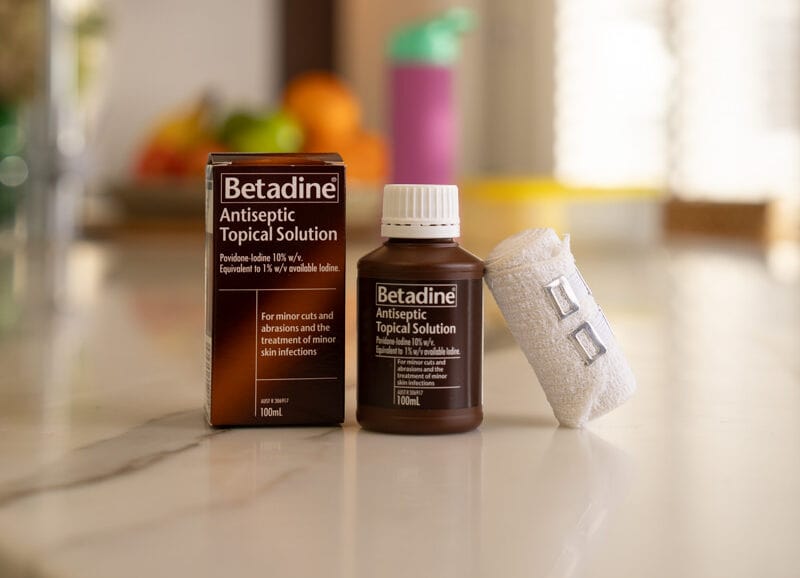
What Is An Antiseptic?
Antiseptics are chemicals that stop or slow the growth of germs and help prevent infections.
Antiseptics are chemicals that stop or slow the growth of germs and help prevent infections. They come in many forms depending on what they are needed for, and are an essential part of first aid. Antiseptics can be used for many different things, from cleaning a wound to sanitising your hands or helping you treat a sore throat.
Why use an antiseptic?
One of the main uses of antiseptics is in first aid. Your skin is the main barrier between the inside and the outside of your body. When your skin is damaged, germs and bacteria from outside your body have the potential to get inside and cause an infection. Applying an antiseptic to a wound can help clean the area and reduce the chance of infection.
Types of antiseptics
Antiseptic comes in many different forms depending on what it is going to be used for. Some of the common forms of antiseptics are:
- Antiseptic Cream – Antiseptic creams such as the Betadine Antiseptic First Aid Cream are used for grazes, minor burns and scalds and the treatment of minor skin infections. They have a cream base for easy application.
- Antiseptic Ointment – Ointments are thick, oil based formulas that are well suited for use on your hands and feet. Ointments such as the Betadine Antiseptic Ointment are ideal for the treatment of common skin infections, e.g. infections of the skin around the nails and prevention of infections in minor burns, cuts and abrasions.
- Antiseptic Solution – Solutions such as the Betadine Antiseptic Topical Solution can be used for minor cuts and abrasions and the treatment of minor skin infections.
- Antiseptic Sprays – Sprays such as the Betadine Antiseptic Liquid Spray are great for minor cuts, abrasions and minor burns and the treatment of minor skin infections.
How do antiseptics work?
Antiseptics work by disrupting processes within bacteria that they need to live, ultimately killing them. Povidone-iodine antiseptics like Betadine contain iodine, which is transported to, and able to get inside the cell walls of microbes. Once the iodine is inside the cell it attacks the DNA, cell walls and amino acids. This not only kills the microorganisms, but also prevents them from multiplying and causing infections.
Which antiseptic is the most effective?
The povidone-iodine that makes up Betadine antiseptic is considered to be able to kill a wide range of microorganisms. This means it is effective against many of the organisms that could cause an infection and is an appropriate antiseptic for open wounds.
What’s the difference between an antiseptic and a disinfectant?
Antiseptics are designed for use on the body, they kill microorganisms in wounds and on the surface of the skin. Disinfectants also kill microorganisms, but they are designed to be used on objects and surfaces. Antiseptics and disinfectants are quite similar and often share some of the same ingredients, however disinfectants are often more concentrated, and may not be suitable for use on your skin.
Frequently asked questions (FAQs)
Betadine Antiseptic First Aid Cream is a great tool for your first aid kit. As an antiseptic it kills germs and helps prevent infection for grazes, minor burns and scalds and may be used in the treatment of minor skin infections.
Some antiseptics contain alcohol or other ingredients which can cause a stinging or burning sensation when applied to open wounds. The Betadine antiseptic range is not formulated with alcohol, and contains povidone-iodine as an antiseptic agent, so may sting less than alcohol-based antiseptics.
Iodine is a powerful antiseptic that is effective against a lot of different types of bacteria. It is able to get inside the cells of the bacteria and kill them from within, stopping them multiplying and causing an infection. Aqueous or alcoholic solutions of iodine can irritate the skin and stain so it is combined with povidone into a povidone-iodine complex. This complex is the active ingredient in various Betadine products.
Treating wounds with antiseptic is a key first step in first aid but if you find yourself without it when you need to clean a wound, don’t worry—there are alternatives. If you hurt yourself and don’t have access to an antiseptic, clean the wound after 5 minutes with sterile saline or clean, running water. Don’t scrub at any embedded dirt, as this can traumatise the site even more. After this, cover the cleaned wound with an appropriate non-stick sterile dressing.
If you don’t have antiseptic DO NOT use a disinfectant instead. Although they may have some of the same ingredients, disinfectants have them at a much higher concentration and using them may cause more damage to your wound.
AU-2024-03-0119